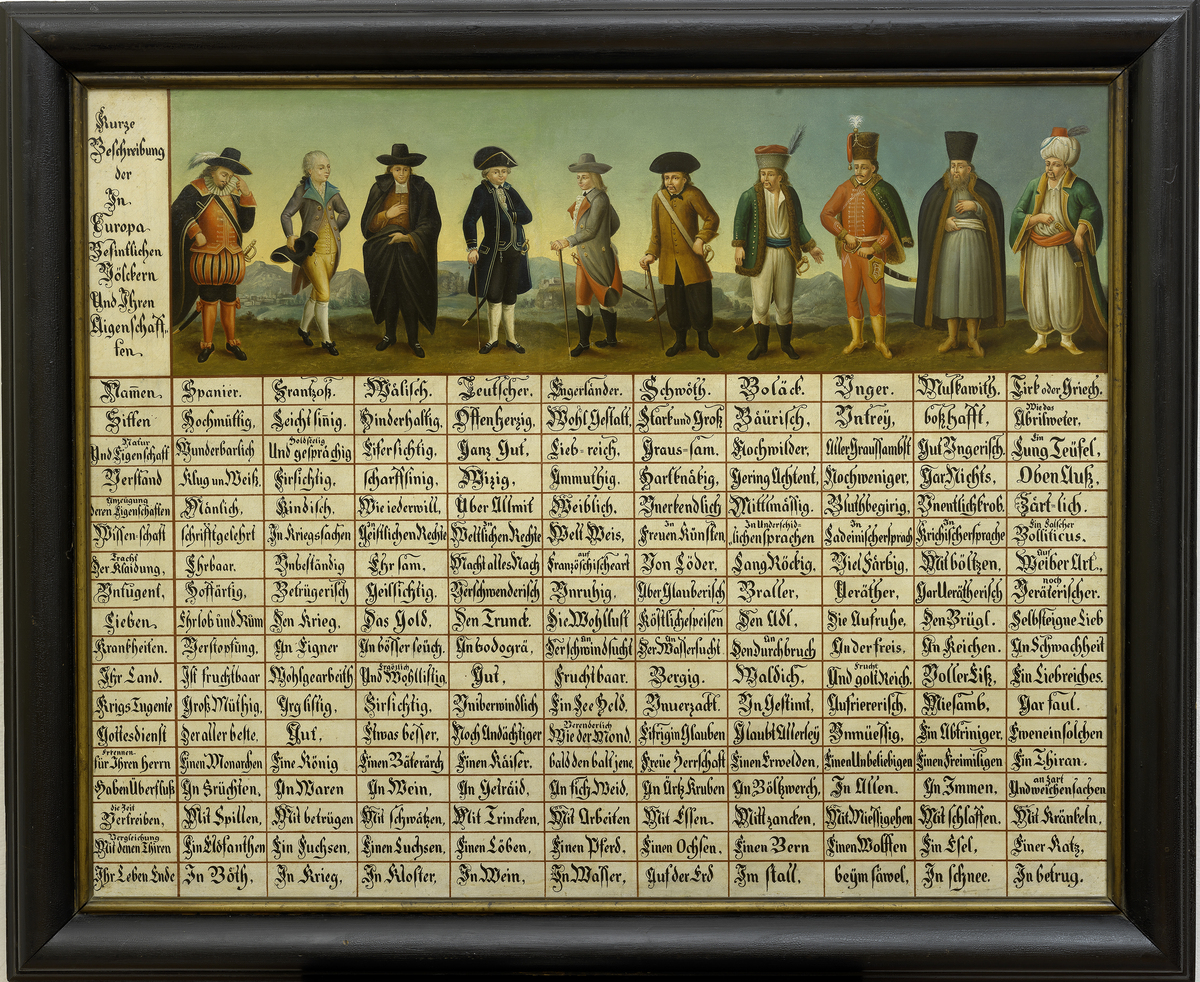European Nations and their “National” Characteristics: An Illustrated Comparison [Völkertafel] (18th Century)
Abstract
Written lists of national stereotypes and clichés have had their place in European ethnographic literature since the beginning of the sixteenth century. They were also expressed visually in works of art—as for instance in the following oil painting, entitled “Short Description of the People Living in Europe and their Characteristics.” The painting features ten male figures, each of whom represents a particular European nation or “people” [Volk] and is dressed accordingly in national and status-appropriate clothing (here: upper class). Represented are (from left to right) Spaniards, the French, Italians, Germans, English, Swedes, Poles, Hungarians, Russians, and Turks or Greeks (in the same category).
The alleged characteristics (e.g., “manners”) of the various figures/nations are described in catchword-form in the corresponding columns. The evaluation criteria are diverse—they include not only climate theory and stage theory [Stufentheorie] but also older, pre-modern classification systems, such as humoral theory. Religious ideas are incorporated, too. Thus, the seven deadly sins are listed in the table. Excessive drinking is listed as a vice of the Germans; imitation in matters of fashion is considered a typical German characteristic. Still, the Germans compare favorably in national comparison.
Source

Source: “Short Description of the People Living in Europe and their Characteristics” [“Kurze Beschreibung der In Europa Befintlichen Völckern Und Ihren Aigenschafften”]. Also referred to as “Table of Peoples” [“Völkertafel”] or “Styrian Table of Peoples” [“Steirische Völkertafel”]. Volkskundemuseum Vienna, Signature: ÖMV/30.905. Available online at: https://volkskundemuseum.at/onlinesammlungen/oemv30905
This work is licensed under the Creative Commons Attribution-NonCommercial-ShareAlike 4.0 License. Only noncommercial uses of the work are permitted.
Further Reading
Thomas Nutz, „Varietäten des Menschengeschlechts“: die Wissenschaften vom Menschen in der Zeit der Aufklärung. Köln: Böhlau Verlag, 2009.
Ute Planert, „Nation und Nationalismus in der deutschen Geschichte“, Aus Politik und Zeitgeschichte 39 (2004), S. 11–18.
Ute Planert, „Wann beginnt der ‚moderne‘ deutsche Nationalismus? Plädoyer für eine nationale Sattelzeit“, in Jörg Echternkamp und Sven Müller, Hrsg., Die Politik der Nation. Deutscher Nationalismus in Krieg und Krisen, 1760–1960 (Studien zur Militärgeschichte, Schriftenreihe des Militärgeschichtlichen Forschungsamtes, Bd. 56), München 2002, S. 25–59.
Georg Schmidt, Hrsg., Die deutsche Nation im frühneuzeitlichen Europa. Politische Ordnung und kulturelle Identität? (= Schriften des Historischen Kollegs, Kolloquien 80), München 2010.